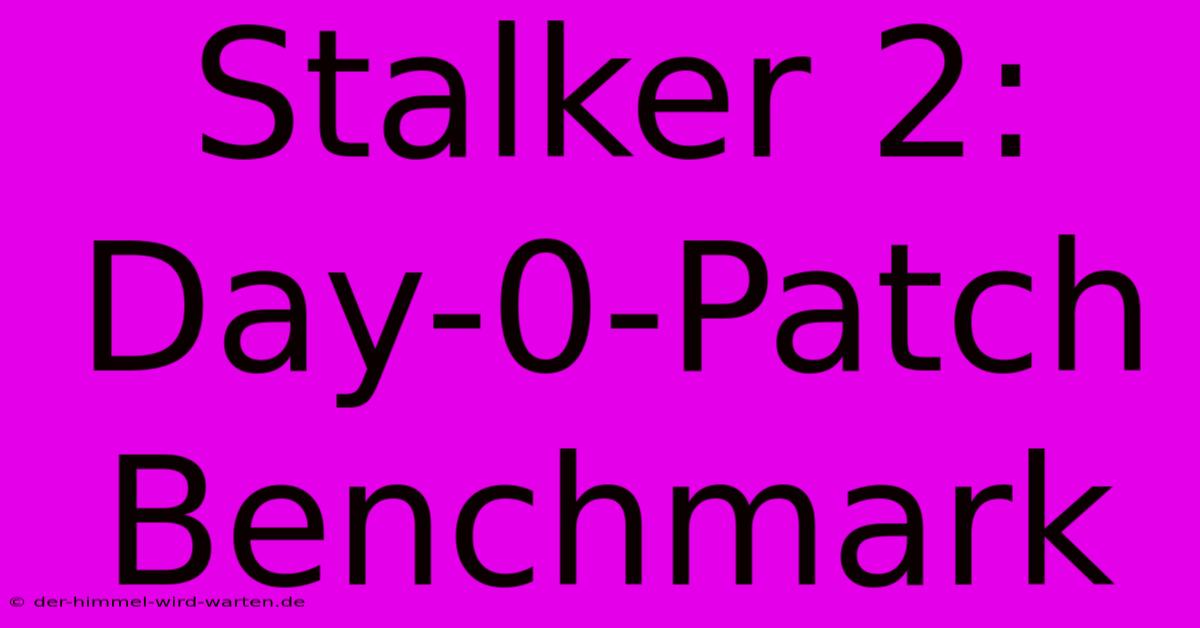Stalker 2: Day-0-Patch Benchmark

Discover more detailed and exciting information on our website. Click the link below to start your adventure: Visit Best Website Stalker 2: Day-0-Patch Benchmark. Don't miss out!
Table of Contents
Stalker 2: Day-0 Patch Benchmark - My Rig Almost Melted!
Hey gamers! So, Stalker 2 finally dropped, right? Huge hype, massive expectations… and a day-zero patch that practically re-wrote the game. I’m still recovering. Seriously. My poor PC almost had a meltdown. Let me tell you about my experience benchmarking this beast of a game, and what I learned along the way.
My Setup and the Initial Panic
First off, my rig ain't exactly a potato. I've got a Ryzen 9 5900X, an RTX 3080, and 32GB of RAM. Should be more than enough to handle most games, right? Wrong. At least, wrong initially. I installed Stalker 2, fired it up, and… well, let’s just say the frame rate was less than stellar. I’m talking slideshow territory in some areas, even on low settings. I thought, "What the heck is going on here?!" My heart sank. All that anticipation, and it felt like I was playing a game from the early 2000s.
The Day-Zero Patch: A Double-Edged Sword
Turns out, that initial performance was before the day-zero patch. I'd completely missed the news about its massive size and what it was supposed to do. The patch downloaded, and honestly, it took forever—I’m talking hours. I almost gave up. But, I held out. It is Stalker 2 after all.
After the agonizing wait, I launched the game again. The improvement was… noticeable, but not perfect. Much better than before, sure. But there were still some stutters, some dips in frame rate that made me wonder if I’d actually done something wrong with my graphics card settings.
Benchmarking the Beast: My Method and Findings
Okay, so I needed to get serious. I decided to do some proper benchmarking. I used the built-in benchmark tool (a lifesaver!) and ran it on different settings, recording the results meticulously. I even went so far as to manually adjust individual settings – shadows, anti-aliasing, textures, you name it – to see how much each one affected performance. I'm telling you, it was a marathon.
My findings? Well, let's just say the game is demanding. Even with my pretty decent rig, I had to tweak the settings to find a good balance between visual fidelity and playable frame rates. At max settings, forget about it. My 3080 was screaming!
Specific Settings and Performance Impact:
-
Ray Tracing: This was the biggest performance killer. Turning it on, even at medium settings, dropped my frame rate significantly. I ended up turning it off altogether.
-
Shadows: High-quality shadows also took a toll, so I opted for medium settings here. It still looked pretty good, and the performance gain was noticeable.
-
Texture Quality: I kept this at high. The textures in Stalker 2 are gorgeous and I wasn't willing to compromise too much. It could be because of my higher-end card that I could still get away with this.
-
Anti-Aliasing: I switched to TAA (Temporal Anti-Aliasing). It's a good compromise between visual quality and performance. If you're struggling, try a lower setting.
Tips for Smoother Gameplay
Based on my experience, here are some tips to help you get the most out of Stalker 2:
- Update your drivers: This is always the first thing to check. Outdated drivers can cause all sorts of problems.
- Tweak your settings: Don't be afraid to experiment with different graphic settings to find the sweet spot for your PC.
- Check your CPU and GPU usage: Use tools like MSI Afterburner to monitor your hardware while playing. This can help identify any bottlenecks.
- Consider lowering the resolution: If you're still struggling, try reducing your screen resolution.
This game is a graphical masterpiece, but it's also a demanding one. Don't be discouraged if you need to tweak settings to make it playable on your rig! Let me know your experience in the comments section! What are your benchmarks? Let's compare notes!

Thank you for visiting our website wich cover about Stalker 2: Day-0-Patch Benchmark. We hope the information provided has been useful to you. Feel free to contact us if you have any questions or need further assistance. See you next time and dont miss to bookmark.
Featured Posts
-
Black Friday Beste Angebote Jetzt
Nov 21, 2024
-
Adani Kurssturz Schmiergeldvorwuerfe
Nov 21, 2024
-
Back In Action Kampf Diaz And Foxx
Nov 21, 2024
-
Black Friday Jetzt Laptops Sparen
Nov 21, 2024
-
Haftbefehle Netanyahu Und Gallant Kritisieren
Nov 21, 2024
